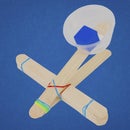Introduction: Motorized Flying Propeller
The Motorized Flying Propeller can fly up to 15' into the air, or even farther horizontally. It's easy to build, endlessly entertaining, and looks as if it should be packaged up as a toy. All you need are basic household tools, easy-to-buy parts, and a big open space to launch your Flying Propeller!
More fun projects like this at STEM-Inventions.com
Step 1: Tools and Materials
Please report broken links
Tools
- Scissors
- Mallet
- Hot glue gun with safety tip
- Soldering iron
- Power drill
- 1/8" drill bit
- drill bit that's wider than your button
Materials
- 1" PVC coupler
- 1" PVC end cap
- 1" - 3/4" PVC slip reducer
- thick straw
- cheap ballpoint pen
- large craft stick
- electrical tape
- plastic propeller*
- 10,000RPM project motor
- AA battery holder
- 2 AA batteries
Optional (not pictured): 7/8" plastic washer
When you make a purchase through these links, I may earn an affiliate commission at zero cost to you.
Step 2: Install the Motor
Install the motor
- Thread the motor wires through the 1" - 3/4" PVC reducer and fit the motor inside as shown.
- Apply hot glue around the perimeter of the motor so it adheres to the inside of the reducer as shown. Make sure the motor shaft is pointing straight up, and that no glue accidentally seeps inside the motor housing.
- Optional: Glue the plastic washer onto the top of the reducer to hide the motor. This is a purely cosmetic feature.
Step 3: Install the Button
Install the Button
- Drill a hole that's wider than your button into one side of the 1" PVC coupler as shown. Make sure that the hole is off-center, so when the button is installed, it won't get in the way of the reducer.
- Remove the nut from the button, then glue it into the hole from the inside of the coupler.
- Screw the nut back onto the button. I lost mine, so I added a metal washer that was bent to conform to the coupler.
Combine the reducer and coupler
- Flip the coupler over and fit the reducer into it.
- You may need to gently tap the reducer with a mallet to get it to insert fully into the coupler. Make sure you don't hit the motor shaft.
Step 4: Solder the Circuit
Solder the circuit
- Solder the black wire from the motor to the red wire from the battery pack.
- Solder the remaining wires.
- Wrap the connections in electrical tape.
- Put the batteries into the battery pack, then test the circuit.
Alternatively, you can skip soldering altogether and instead simply strip about 1" off of the ends of the wires and twist them together.
Step 5: Assemble the Motor Housing
Assemble the motor housing
- Fit the battery pack into the coupler.
- Bundle the wires and fit those between the battery pack and the coupler.
- Slip the 1" end cap over the battery pack and wires.
- Wrap a piece of duct tape around the seam between the coupler and end cap.
If you ever need to replace the batteries, simply undo the tape.
Step 6: Install the Propeller Mount
Install the propeller mount
- Pull the plastic tip off of the ballpoint pen.
- Fill the plastic tip with hot glue
- Insert the motor shaft into the pointed end of the plastic tip, and hold it straight up-and-down.
- Wait for the glue to dry, then test. The propeller mount should spin at a very high speed with little to no vibration.
This is the most crucial step. If the propeller mount is not straight up-and-down, then it will wobble, which will cause the propeller to wobble as well. If the propeller mount is not straight, pull it off and try again with a new pen tip.
Step 7: Glue on the Propeller Shaft
Glue on the propeller shaft
- Cut a piece of straw about 1/2" long. It should be slightly longer than the part of the pen tip that fits inside the pen casing.
- Place a glob of hot glue onto the propeller as shown, then attach the straw.
- Look straight down at the propeller and center the straw as shown.
This is also a crucial step, so make sure the straw is as centered as possible.
Step 8: How to Fly
How to fly
- Place the propeller onto the motor.
- Gently press the top of the propeller with the large craft stick.
- Turn on the motor and speed up the propeller. Listen to the pitch of the propeller: it will become audibly higher when it has reached maximum speed.
- Quickly pull the craft stick up and away from the propeller - the flying propeller will spring into the air!
This technique can also be used to fly the propeller sideways, or even upside down on a table like a top.
Avoid leaning over the propeller, or operating it at eye-level. If the craft stick hits the propeller when being pulled away, the propeller may fly off in a sideways direction.
Troubleshooting
- If the propeller is wobbling:
- the motor shaft is crooked
- the straw is too wide
- the straw is too long or too short
- the straw is not centered
- If the propeller is spinning the wrong way:
- flip the polarity of the batteries.

Participated in the
Make It Fly Contest 2016













